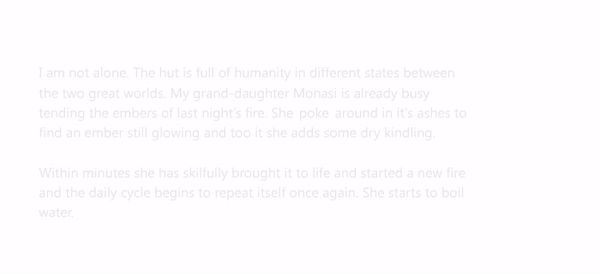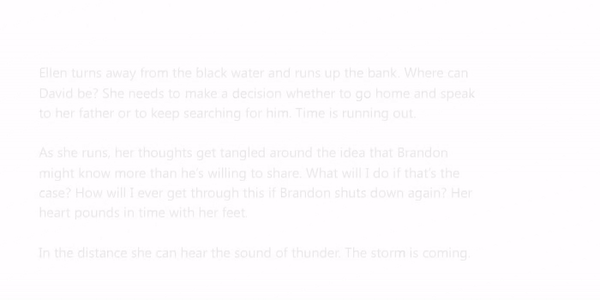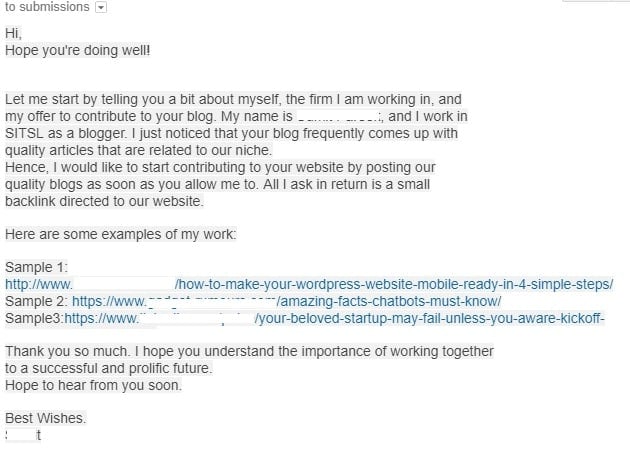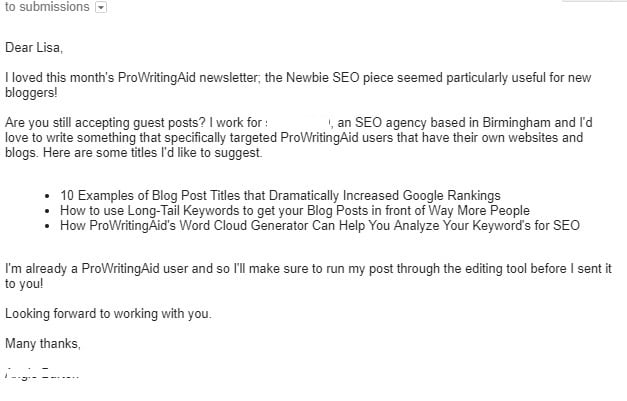Outreach is a key element in your online marketing strategy.
Influencers can help you broaden your reach exponentially with a single tweet or backlink.
Making connections, spreading influence, and maximizing your online visibility through amazing content can boost your brand quickly.
However, bad content will sabotage your hard-earned outreach efforts, eliminating any progress you made.
Here are 10 instances of bad content that will sabotage your outreach efforts and what you should do instead.
#1—Awful first sentences
You have around one-tenth of a second to make an impression. A lame first sentence will cause most to click away.
For example, Hubspot says starting an outreach email with “My name is…” or “I work for…” is not only boring and unoriginal, most people aren’t interested, frankly.
Other phrases like “Did you know…” or “I’ve been thinking…” put a reader off immediately because they don’t really want to know what you’ve been thinking about.
Awful first sentences are like a huge neon sign blinking on and off that reads “I’m trying to get something from you.”
Unless, of course, you’re representing a large, internationally-known corporation, which could be a door-opener.
Instead, start your email with “[Person’s name] recommended we get in touch” or “You posted a great article on X in the Y group on LinkedIn yesterday.”
The trick is to personalize the first sentence, which means you should begin your sentence with “You” rather than “I.”
You’ll have a better chance of catching someone’s attention if you dive right into your message.
#2—Awful endings
Much like first sentences, ending your outreach efforts can make a difference in response rates.
The average person gets over 200 emails a day; you need a way to stand out from the crowd.
An ending can keep you top of mind for a variety of reasons—make it a good one.
Neuromarketing quoted a study that found safe-bet endings are “cheers,” “kinds regards,” and “best,” which range from 14.5%, 13.5%, and a 7.8% increase in response rate, respectively.
But you can do better.
Your email’s closing should give context to your outreach. In particular, thankful closings prompt the best response rates:
- Thanks in advance—38.3% increase
- Thanks—32.6% increase
- Thank you—21.9% increase
Gratitude is always good for boosting positive emotions between you and your recipient, and it sets an expectation of cooperation.
#3—Focus on benefits
Don’t focus on presenting every feature of your product. Going on ad nauseam is the swiftest way to get your email deleted.
Instead, tell them a story about how others have benefitted from using your product.
People respond to stories according to Harvard Business Review, especially stories about others just like themselves who have succeeded or overcome obstacles.
Give your reader an idea or a mental image of how you can help him and make it worth his valuable time.
You want to show how your recipient can benefit from responding to your email.
Always offer something that is equal to or more valuable than their time.
This is a great example of an outreach pitch that made me want to collaborate (even though there is a typo in the first sentence!):
#4—Average ideas or content
Build your outreach efforts on solid, fresh, and original ideas and content.
Asking someone you don’t know to share average ideas or content will never get you the outreach you need.
In fact, the person on the receiving end will likely never look at another email from you.
Take the time to be creative and original.
Put forward your best ideas or content, no matter where or who you’re targeting.
In fact, the more you create targeted content for outreach, the better your response rate.
The Daily Egg has an excellent post on how to make it so good that they can’t say no to your offer and will be inspired to share your link or article.
Perhaps the worst thing you can do is copy and paste your outreach content.
You get in trouble when you forget to remove copy targeting other influencers or target markets from your content, proving that your campaign is staged and impersonal.
You don’t want influencers to think that they’re part of a cookie-cutter outreach operation.
#5—Sloppy communications and content
Nothing makes you look more amateur than poorly-written, error-filled content.
If you can’t be bothered to take the time to edit and proofread your writing, then don’t bother sending it.
They will hit delete before they even reach the end.
You need to use an editing tool to strengthen and polish every piece of writing before you push send.
Even the best writers and editors make technical and stylistic gaffes that take their content from outstanding to mediocre.
An editing tool like ProWritingAid will capture multiple ways to improve your writing that you’re just too close to your work to catch.
#6—Divergent target markets
Let’s say, for example, you are working on an outreach campaign for a company that offers custom-made holidays.
Don’t direct your outreach efforts at a website that specialises in shoes.
While some people might like to have new shoes before leaving on holiday, most will not see a connection.
You need to find the communities that share your target market.
Make it very clear in your outreach emails how and where your communities overlap online.
The best outreach campaigns will have a well-thought-out marketing plan in advance of reaching out to influencers.
If you want a great response, show influencers how everything is laid out in front of them and the interconnections between their audience and your target market.
It will help them make their decision quicker and easier, saving time and helping to deliver awesome results.
#7—Mass emails
Sending out generic mass emails is spam, regardless of your intent.
Good outreach practices do not include the scattergun approach of sending vague emails to a lot of individuals you don’t follow or found at random.
Especially with influencers, give them credit for being able to tell that you have merely replaced the name at the top of a mass email and sent it to them.
If your business or content doesn’t mesh with the content they produce, you won’t connect or get a link back.
This is an example of an email I received this morning (I’ve blocked the names and specific websites):
They haven’t bothered to find out my name or mention anything about our product.
The example content has nothing to do with our area of expertise.
I didn’t even bother to respond.
Instead, carefully target people whose work you know and follow and who have similar interests or expertise.
Any good outreach program relies on a mutually beneficial relationship, so make sure you’re being deliberate and strategic with your outreach efforts.
Let them know what you can offer that will be beneficial to them.
To compare, I receive the email below on the same day. It’s clearly been customized specifically for me:
It’s not perfect but I will definitely reply and see if we can work together.
Personalizing your communication and including relevant links to content on an influencer’s website will help show that you are familiar with their audience and what they like to see.
#8—Too many (or not enough) options
It’s always good to give your readers choices for calls to action.
What can sabotage your efforts is giving one terse call to action or so many that they have analysis paralysis.
Go for somewhere in the middle such as a 2-3 item limit.
This avoids the hard sell of a single call to action (such as “Let me know the date that works best for a phone call”).
It also avoids offering them so many alternatives that they put your email aside to think about later.
#9—Clickbait subject lines
Gimmicky subject lines that are nothing more than clickbait will sabotage not only your outreach efforts, but also any future campaigns.
For example, you may get emails with a subject line like:
- “RE: ____________” where the subject leads you to believe it’s part of an earlier email thread
- “Your copy is enclosed” with a link to a standard opt-in form in exchange for your personal information
- An astonishing statement that doesn’t relate to the email’s content
You want to honestly and transparently grab readers’ attention.
If you think your subject lines may sabotage your outreach, send your emails to team members, peers, or colleagues first.
Get their feedback on subject lines and body content before sending out emails.
#10—Making it about social media instead of the relationship
Influencers are not in the position to simply collect a paycheck for helping out on a media campaign.
They want to create relationships with brands and people.
That’s generally how they became influencers in the first place.
So an outreach campaign with any influencer must benefit both your brand and theirs.
The only way to accomplish that is through a relationship.
The beauty of developing a relationship is that an influencer is more likely to talk about your brands in real life, beyond merely posting about it.
A relationship can drive an influencer to go above and beyond, especially if they feel a connection to what your brand stands for.
Get influencers personally invested in your vision and mission, and they’ll feel compelled to live it and promote it.
Conclusion
Remember, outreach—if it’s done thoughtfully— is beneficial to your prospects.
You are offering them something that they can use in their marketing efforts.
Think about what they would make their jobs easier and offer that.
If you follow the tips above, you will be less likely to sabotage your efforts with bad content and more likely to increase your open and conversion rates.
Lisa Lepki is the Editor of the ProWritingAid blog. A word nerd, she loves the technical elements of writing almost as much as the writing itself. Her work can be found on Writer’s Digest, bookbaby.com, The Write Life, and DIYAuthor.






